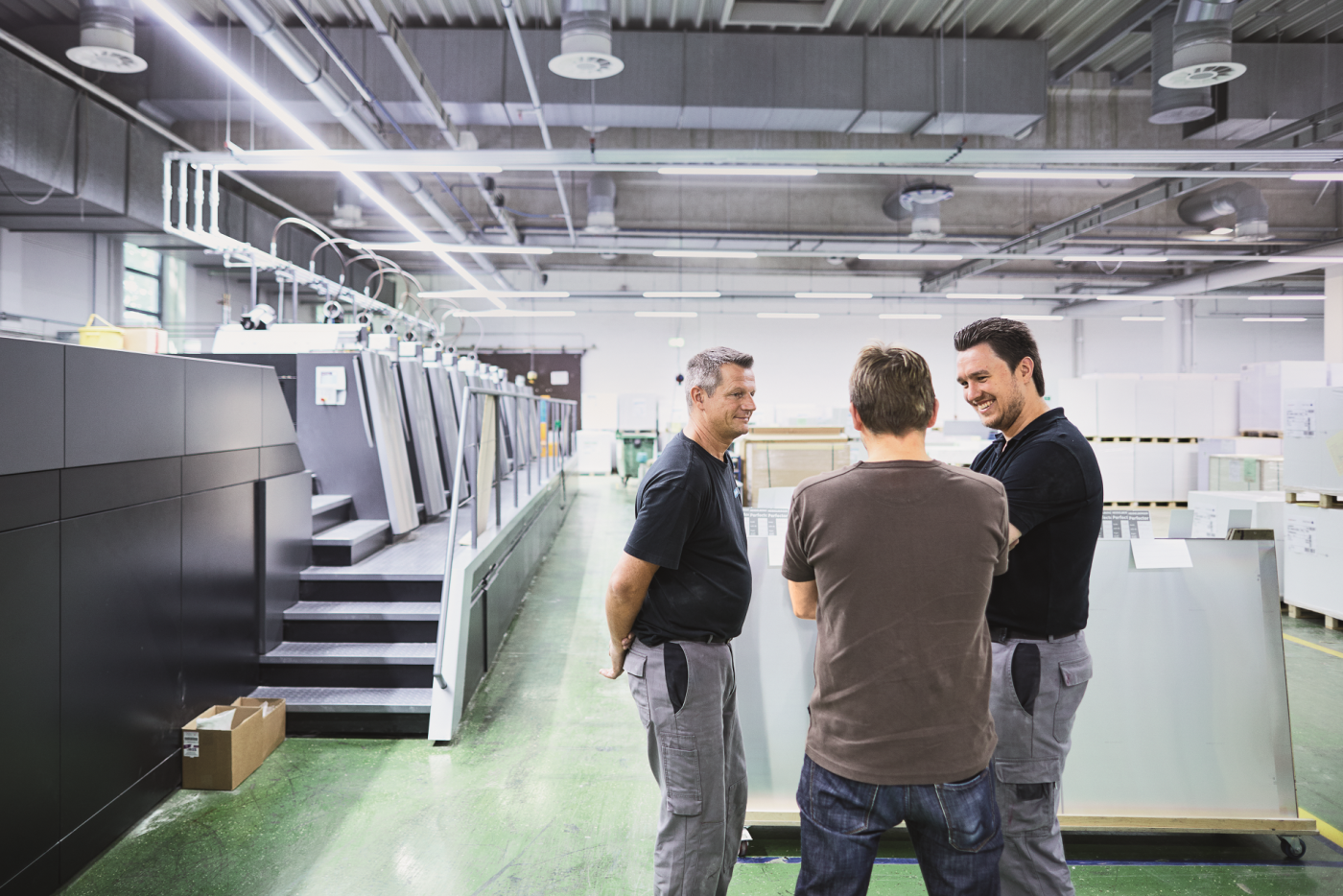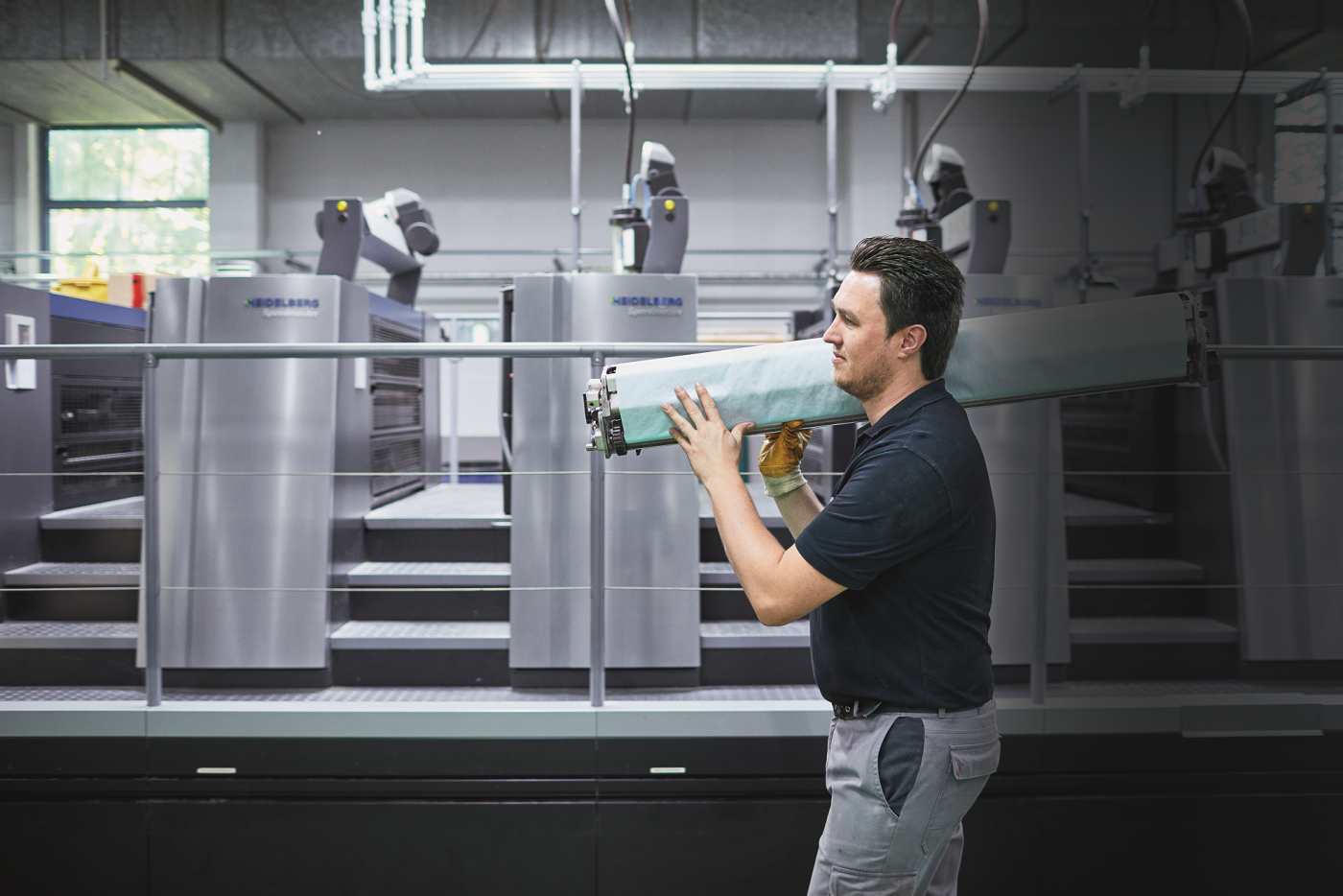Mr. Dembinski, how do you wish to be perceived on the market as a company?
Robert Dembinski: As the most innovative, state-of-the-art printing operation in North Rhine-Westphalia (Germany). That might sound a bit like patting ourselves on the back, but it’s how we would like people to see us and what we aim toward. That’s why we set great store in always working with the very latest equipment available on the market.
Is that why you opted for the subscription model?
Robert Dembinski: It’s our great fortune to have a publishing house as our parent company. However, the subscription model was still of interest to us, as we are constantly considering how to keep on optimizing our printing operations. And the full package from Heidelberg fitted the bill precisely.
How did you hear about it?
Robert Dembinski: At the end of 2017, we wanted to acquire a new press and gathered various offers. Heidelberg presented this model to us, which at that time wasn’t yet on the market. The concept immediately made sense to us, and so we became the first offset print shop in Germany to sign up.
What makes the model so appealing to you?
Robert Dembinski: It’s the perfect way for us to boost our performance. I’m certain we wouldn’t have achieved the same level of improvement simply by purchasing a press – certainly not in this short time.


Why not?
Robert Dembinski: Besides the new Speedmaster XL 106, the key to boosting our performance was the Performance Plus consultancy concept included in the contract. We benefited immensely from this because the new Speedmaster XL 106 requires an entirely different working method if you want to get the best out of its fully automated capabilities. To enable us to achieve this, the experts at Heidelberg analyzed all the processes, going into fine detail in each and every aspect. For example, the printers’ foot routes, and how the paper or printing plates reach the presses. Heidelberg mapped the routes and coordinated each with minute precision, basically choreographing the whole thing – even the waste disposal. That’s exactly what we wanted, to push our productivity to its limits and be on a par with the best.
How do you know who’s the best?
Robert Dembinski: Because Heidelberg knows and shares that knowledge with us. Once a month, we hold a conference call and get all the figures we need. For example, we see how our makeready times compare to other companies using the same machines. And we immediately identify the points in the process where we still have some catching up to do.
Where have you been able to significantly improve your processes?
Robert Dembinski: Some of the changes were small – but had a major effect. We wouldn’t have necessarily hit upon these ourselves. For instance, already bending the plates at the prepress stage and taking them to the press so the printers no longer have to fetch them themselves. Or setting up a buffer for paper in front of the press so printers don’t have to walk so far for this, either.
It really is worth checking every single step during the makeready process and optimizing it as appropriate. Even if we end up gaining just ten seconds from a particular optimization, this still adds up to several hours over the course of approx. 15,000 plate changes per year.
In total, we have succeeded in reducing our makeready times by around 40 percent thanks to the various optimizations. Incidentally, Performance Plus has also had a positive effect on the productivity of our other machines.
How?
Robert Dembinski: In some cases, our printers work on both the Speedmaster and other presses. They of course apply the new method learned on the Speedmaster to working on other presses as well. As a result, our ten-year-old press supplied by a competitor is now 15 to 20 percent more productive.


How do you now rate the subscription model?
Robert Dembinski: We said from the start that we wanted to be leading innovators and achieve maximum performance. This model enables us to do just that. Not only are we operating the latest Heidelberg press, but at maximum productivity. Ultimately, it doesn’t matter whether I own the press. The arrangement just has to be profitable – which it is. This makes me a fan of the subscription model.
Apart from that, the full package has really helped us streamline our complex processes, and our outlay has been greatly reduced. For example, it has radically simplified our entire ordering process, as Heidelberg provides everything we need for printing and even performs all the logistics. So the model pays dividends for us in many respects.
If you were the managing director of a smaller company, would you still opt for this model?
Robert Dembinski: I would need to weigh things up in detail. I consider the model only partially suitable for smaller businesses, as they might not be able to sell the extra capacity it creates, which they would need to. It’s important to me that printing businesses, whatever their size, don’t rely purely on their own expertise, but are receptive to the knowledge possessed by external partners such as Heidelberg. Even experienced printers can still learn things this way. No element of the printing process is beyond improvement
What improvements are you currently working on to boost your productivity even further?
Robert Dembinski: By now, we’re already very well placed, technologically. But there are certain points we can still refine even further, such as in setup waste and production speed. We can see where potential still lies in the graphic overview of benchmarks provided by Heidelberg, which lists the key parameters of more than one hundred other machines. And I would not be a good managing director if I didn’t aim to be among the best.

Lensing Druck is owned by Lensing Media, the second-largest newspaper publisher in the Ruhr region of Germany and home to tradition-steeped newspapers such as “Ruhrnachrichten”. Heinrich Lensing founded the publishing house in 1870. His son, Lambert Lensing, was a newspaper publisher who went on to enter the German Bundestag and also helped draft the constitution adopted by the Federal Republic in 1949.
In the 1970s and ‘80s, the publishing house took over further regional newspapers, ventured into radio broadcasting and launched its own private postal delivery service. Lensing Druck has been a firm part of the organization, which has been family-run for more than a century, since the start.
The acquisition of Druckerei Hitzegrad in early 2015 marked a milestone, after which the company pooled its sheetfed offset and digital printing operations at a new site in the Kley district of Dortmund. Lensing Druck currently employs 120 staff at its 64,500 square-foot (6,000 sq. m) production facility. At its heart is a printing press from Heidelberg – a nine-color Speedmaster XL 106 with coating unit. Lensing prints between 65 and 70 million sheets a year on average. The approximately 4,500 orders stem only partly from the publishing house itself.
It also prints brochures, art catalogs, magazines and books for customers in cultural, association and publishing spheres, industry and the public sector.
Lensing Druck provides a complete range of media services that extends beyond conventional printing to include converting, logistics and lettershop services. The print shop intends to harness its potential even more effectively in the future. Firstly, by focusing more heavily on cross-selling effects and closer collaboration with publishing sales; secondly, by optimizing the productivity of its machinery. The subscription model from Heidelberg is a key lever in this respect.

Digital Services help print shops increase their performance and availability efficiently.

“Production is easier to plan, delivery times are shorter, less space is needed for interim storage and less capital is tied up for semi-finished products ...”

HEIDELBERG News features articles about industry trends, new technologies, print applications as well as success stories of print shops from around the world.